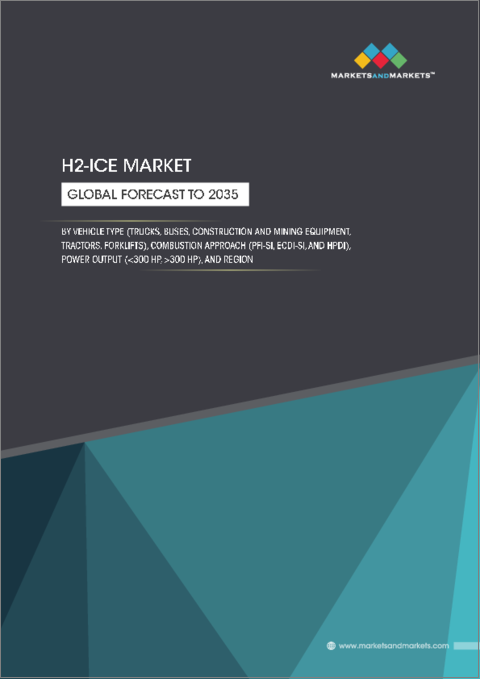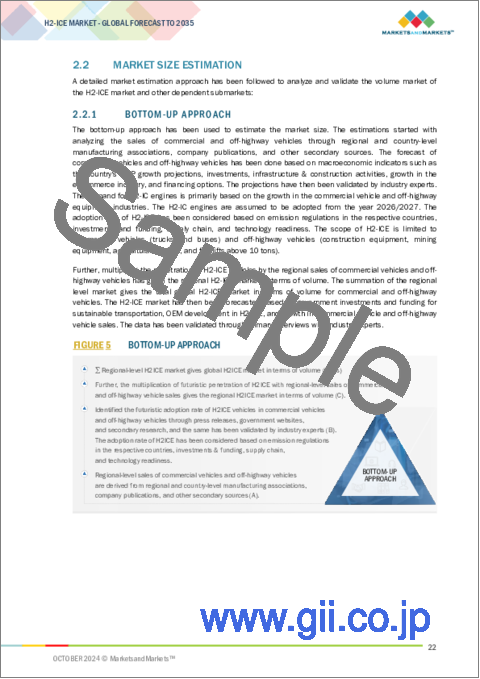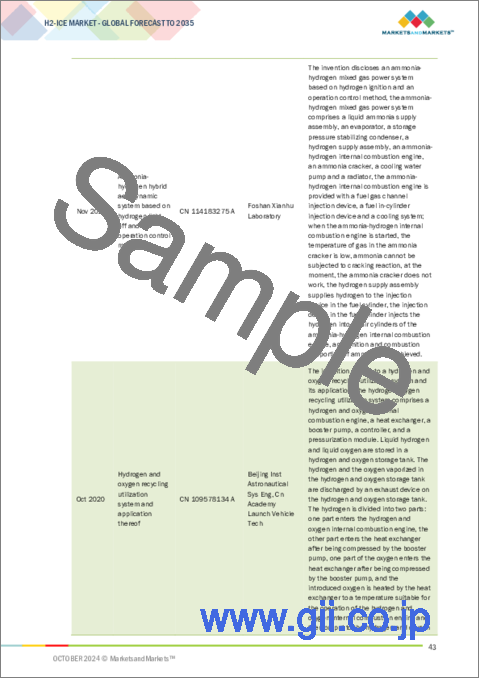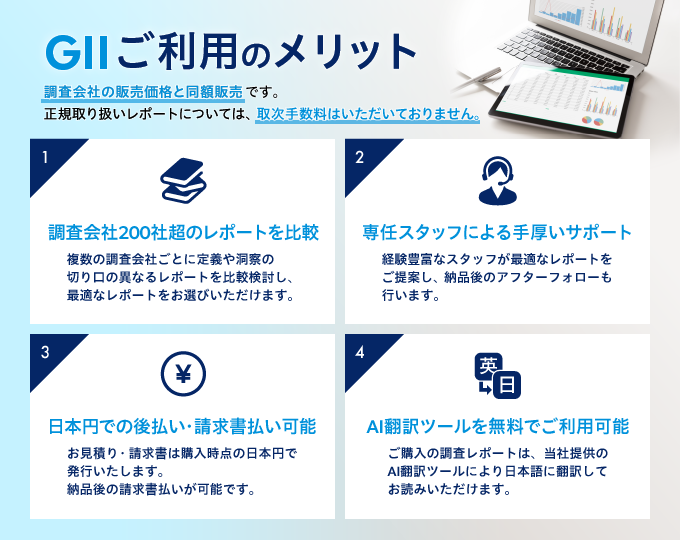|
|
市場調査レポート
商品コード
1592564
H2-ICEの世界市場- 車両タイプ別、燃焼方式別、出力別、地域別 - 2035年までの予測H2-ICE Market by Vehicle Type (Trucks and Buses, Construction Equipment, Mining Equipment, Farm Tractors, Industrial Forklifts), Combustion Approach (PFI-SI, ECDI-SI, and HPDI), Power Output (<300HP, >300 HP) and Region - Global Forecast to 2035 |
||||||
カスタマイズ可能
|
|||||||
| H2-ICEの世界市場- 車両タイプ別、燃焼方式別、出力別、地域別 - 2035年までの予測 |
|
出版日: 2024年11月07日
発行: MarketsandMarkets
ページ情報: 英文 129 Pages
納期: 即納可能
|
全表示
- 概要
- 図表
- 目次
他のほぼゼロ排出技術に対するH2-ICEの利点が、市場を牽引すると予想されています。
水素内燃エンジンは、バッテリー電気自動車や燃料電池電気自動車などの他のほぼゼロまたはゼロ排出技術に比べて特定の利点があります。バッテリーの重量とサイズは、車両の積載量に大きく影響する主要な懸念事項です。このため、水素ICエンジンは、重い負荷条件を管理する能力により、大型商用車のより良い選択肢になる可能性があります。H2-内燃機関車の範囲もBEVやFCEVと比較的似ていますが、燃料補給が速いという利点があり、水素ガス用にいくつかの変更を加えることで、利用可能な燃料補給ステーションを利用することもできます。H2-ICEの初期コストは、BEVやFCEVよりも大幅に低くなると予想されており、大型商用車にとってより良い選択肢となります。
| 調査範囲 | |
|---|---|
| 調査対象年数 | 2027年~2035年 |
| 基準年 | 2024年 |
| 予測期間 | 2031年~2035年 |
| 検討単位 | 数量(千1,000)と金額(100万米ドル) |
| セグメント | 車両タイプ別、燃焼方式別、出力別、地域別 |
| 対象地域 | アジア太平洋、北米、欧州 |
オンハイウェイ車両は、2030年以降、H2-ICEパワートレイン技術の最大の市場になると予想されています。この成長は、貨物および物流部門における持続可能な輸送ソリューションの需要増加が主な原因です。インド、中国、米国などの国には、長距離トラックが十分なパフォーマンスで長距離を継続的に走行する必要がある広範な高速道路ルートネットワークがあります。エンジン容量が8~10リットルの範囲のH2-ICEテクノロジーは、比較的長い走行距離と少ない燃料補給能力を提供します。これらの国では高速道路での充電インフラが限られているため、純粋な電気トラックや燃料電池トラックは長距離走行用途には考慮されていません。H2-ICEは従来のディーゼルエンジンに基づいているため、追加の実質的なコストが限られており、フリートオペレーターの運用ニーズにより適しています。
鉱山機械では、ホイールローダーやダンプトラックなどの一部の機器カテゴリーで、H2-ICE技術の採用が注目される可能性があります。従来のディーゼル駆動機器から持続可能な鉱山機械への移行は、排出量の削減と運用効率の向上に不可欠であり、水素エンジンはこの移行をサポートする上で重要な役割を果たすことができます。リープヘル(スイス)は、後年、重機や鉱山機械に搭載できる水素エンジン(H966およびH964)を開発しています。オフハイウェイ機器メーカーが水素エンジンを搭載した連結式ダンプトラックを設計する可能性もあります。現在、ABボルボ(スウェーデン)は燃料電池を動力とする連結式ダンプトラックを提供していますが、水素技術の進歩により、欧州やラテンアメリカ諸国の鉱山現場で配備されるこれらの車両にもH2-ICEエンジンが搭載されることが期待されます。
当レポートでは、世界のH2-ICE市場について調査し、車両タイプ別、燃焼方式別、出力別、地域別動向、および市場に参入する企業のプロファイルなどをまとめています。
目次
第1章 イントロダクション
第2章 調査手法
第3章 エグゼクティブサマリー
第4章 市場概要
- イントロダクション
- 市場力学
- 顧客ビジネスに影響を与える動向/混乱
- ケーススタディ分析
- 特許分析
- 投資と資金調達のシナリオ
- エコシステム分析
- 企業レベルのエコシステム
- 階層型エコシステム
- 規制分析
- 2024年~2025年の主な会議とイベント
- 2035年までのH2-ICE導入ロードマップ
- 水素燃料サプライチェーン
第5章 総所有コスト分析
第6章 H2-ICE市場、供給マトリックス
第7章 技術比較
第8章 H2-ICE市場、エンジン部品への影響
第9章 H2-ICE市場、H2-ICEとBEVとディーゼルの将来の可能性
第10章 H2-ICE市場、車両タイプ別
- イントロダクション
- オンハイウェイ車両
- オフロード車両
- 業界考察
第11章 H2-ICE市場、燃焼方式別
- イントロダクション
- スパーク点火式ポート燃料噴射(PFI-SI)
- 高圧直接噴射(HPDI)
- 早期サイクル直接噴射スパーク点火(ECDI-SI)
- 業界考察
第12章 H2-ICE市場、出力別
- イントロダクション
- 300HP未満
- 300HP以上
- 業界考察
第13章 H2-ICE市場、地域別
- イントロダクション
- アジア太平洋
- 欧州
- 北米
- 業界考察
第14章 競合情勢
- 概要
- 主要参入企業の戦略/強み、2020年~2024年
- 市場ランキング分析、2024年
- 財務指標
- ブランド/製品比較
- 競合シナリオ
- サプライヤー分析
- その他のテクノロジー/コンポーネントプロバイダー
第15章 企業プロファイル
- 主要参入企業
- CUMMINS INC.
- DEUTZ AG
- ASHOK LEYLAND
- PACCAR INC.
- AB VOLVO
- HD HYUNDAI INFRACORE
- MAN
- J C BAMFORD EXCAVATORS LTD.
- LIEBHERR
- KEYOU GMBH
第16章 最終的な結論と推奨事項
List of Tables
- TABLE 1 SEGMENT-WISE INCLUSION AND EXCLUSIONS
- TABLE 2 RESEARCH ASSUMPTIONS AND ASSOCIATED RISKS
- TABLE 3 GOVERNMENT REGULATIONS TO REDUCE GREENHOUSE GAS EMISSIONS FROM HEAVY-DUTY TRUCKS
- TABLE 4 GOVERNMENT FUNDING FOR H2-ICE
- TABLE 5 BENEFITS OF HYDROGEN OVER OTHER NEAR-ZERO EMISSION TECHNOLOGIES
- TABLE 6 STORAGE COMPARISON: DIESEL VS. H2-ICE
- TABLE 7 PATENTS PUBLISHED
- TABLE 8 ROLE OF PLAYERS IN H2-ICE MARKET ECOSYSTEM
- TABLE 9 NORTH AMERICA: LIST OF REGULATORY BODIES, GOVERNMENT AGENCIES, AND OTHER ORGANIZATIONS
- TABLE 10 EUROPE: LIST OF REGULATORY BODIES, GOVERNMENT AGENCIES, AND OTHER ORGANIZATIONS
- TABLE 11 ASIA PACIFIC: LIST OF REGULATORY BODIES, GOVERNMENT AGENCIES, AND OTHER ORGANIZATIONS
- TABLE 12 H2-ICE MARKET: LIST OF KEY CONFERENCES AND EVENTS, 2024-2025
- TABLE 13 H2-ICE ADOPTION ROADMAP TO 2035
- TABLE 14 ASSUMPTIONS IN TOTAL COST OF OWNERSHIP ANALYSIS
- TABLE 15 TECHNOLOGY COMPARISON BETWEEN H2-ICE VS. DIESEL VS. FCEV VS. BIOFUEL
- TABLE 16 FUTURE POTENTIAL OF H2-ICE VS. BEV VS. DIESEL, 2030 VS. 2035
- TABLE 17 H2-ICE MARKET, BY VEHICLE TYPE, 2024-2030 (UNITS)
- TABLE 18 H2-ICE MARKET, BY VEHICLE TYPE, 2031-2035 (UNITS)
- TABLE 19 TRUCKS: H2-ICE MARKET, BY REGION, 2024-2030 (UNITS)
- TABLE 20 TRUCKS: H2-ICE MARKET, BY REGION, 2031-2035 (UNITS)
- TABLE 21 BUSES: H2-ICE MARKET, BY REGION, 2024-2030 (UNITS)
- TABLE 22 BUSES: H2-ICE MARKET, BY REGION, 2031-2035 (UNITS)
- TABLE 23 OFF-HIGHWAY VEHICLES: H2-ICE MARKET, BY TYPE, 2024-2030 (UNITS)
- TABLE 24 OFF-HIGHWAY VEHICLES: H2-ICE MARKET, BY TYPE, 2031-2035 (UNITS)
- TABLE 25 BACKHOE LOADERS: H2-ICE MARKET, BY REGION, 2024-2030 (UNITS)
- TABLE 26 BACKHOE LOADERS: H2-ICE MARKET, BY REGION, 2031-2035 (UNITS)
- TABLE 27 CRAWLER EXCAVATORS: H2-ICE MARKET, BY REGION, 2024-2030 (UNITS)
- TABLE 28 CRAWLER EXCAVATORS: H2-ICE MARKET, BY REGION, 2031-2035 (UNITS)
- TABLE 29 ARTICULATED DUMP TRUCKS: H2-ICE MARKET, BY REGION, 2024-2030 (UNITS)
- TABLE 30 ARTICULATED DUMP TRUCKS: H2-ICE MARKET, BY REGION, 2031-2035 (UNITS)
- TABLE 31 WHEEL LOADERS: H2-ICE MARKET, BY REGION, 2024-2030 (UNITS)
- TABLE 32 WHEEL LOADERS: H2-ICE MARKET, BY REGION, 2031-2035 (UNITS)
- TABLE 33 CONCRETE MIXERS: H2-ICE MARKET, BY REGION, 2024-2030 (UNITS)
- TABLE 34 CONCRETE MIXERS: H2-ICE MARKET, BY REGION, 2031-2035 (UNITS)
- TABLE 35 TRACTORS: H2-ICE MARKET, BY REGION, 2024-2030 (UNITS)
- TABLE 36 TRACTORS: H2-ICE MARKET, BY REGION, 2031-2035 (UNITS)
- TABLE 37 FORKLIFTS: H2-ICE MARKET, BY REGION, 2024-2030 (UNITS)
- TABLE 38 FORKLIFTS: H2-ICE MARKET, BY REGION, 2031-2035 (UNITS)
- TABLE 39 TECHNOLOGY COMPARISON BETWEEN PFI-SI VS. HDPI VS. ECDI SI
- TABLE 40 OEM-WISE ENGINE SPECIFICATIONS AND TECHNOLOGY FOR PFI-SI
- TABLE 41 OEM-WISE ENGINE SPECIFICATIONS AND TECHNOLOGY FOR HPDI
- TABLE 42 H2-ICE OFFERINGS FOR BELOW 300 HP ENGINES BY KEY ENGINE MANUFACTURERS
- TABLE 43 H2-ICE OFFERINGS FOR ABOVE 300 HP ENGINES BY KEY ENGINE MANUFACTURERS
- TABLE 44 H2-ICE MARKET, BY REGION, 2024-2030 (UNITS)
- TABLE 45 H2-ICE MARKET, BY REGION, 2031-2035 (UNITS)
- TABLE 46 ASIA PACIFIC: H2-ICE MARKET, BY VEHICLE TYPE, 2024-2030 (UNITS)
- TABLE 47 ASIA PACIFIC: H2-ICE MARKET, BY VEHICLE TYPE, 2031-2035 (UNITS)
- TABLE 48 EUROPE: H2-ICE MARKET, BY VEHICLE TYPE, 2024-2030 (UNITS)
- TABLE 49 EUROPE: H2-ICE MARKET, BY VEHICLE TYPE, 2031-2035 (UNITS)
- TABLE 50 NORTH AMERICA: H2-ICE MARKET, BY VEHICLE TYPE, 2024-2030 (UNITS)
- TABLE 51 NORTH AMERICA: H2-ICE MARKET, BY VEHICLE TYPE, 2031-2035 (UNITS)
- TABLE 52 KEY PLAYER STRATEGIES/RIGHT TO WIN, 2020-2024
- TABLE 53 H2-ICE MARKET: DEVELOPMENTS, 2021-2024
- TABLE 54 H2-ICE: WHO SUPPLIES WHOM, 2021 -2024
- TABLE 55 ROBERT BOSCH GMBH
- TABLE 56 EATON
- TABLE 57 GARRETT MOTION INC.
- TABLE 58 FORVIA SE
- TABLE 59 MAHLE GMBH
- TABLE 60 CUMMINS INC.: COMPANY OVERVIEW
- TABLE 61 CUMMINS INC.: PRODUCT OVERVIEW
- TABLE 62 CUMMINS INC.: RECENT DEVELOPMENTS
- TABLE 63 DEUTZ AG: COMPANY OVERVIEW
- TABLE 64 DEUTZ AG: PRODUCT OVERVIEW
- TABLE 65 DEUTZ AG: RECENT DEVELOPMENTS
- TABLE 66 ASHOK LEYLAND: COMPANY OVERVIEW
- TABLE 67 ASHOK LEYLAND: PRODUCT OVERVIEW
- TABLE 68 ASHOK LEYLAND: RECENT DEVELOPMENTS
- TABLE 69 PACCAR INC.: COMPANY OVERVIEW
- TABLE 70 PACCAR INC: PRODUCT OVERVIEW
- TABLE 71 PACCAR INC.: RECENT DEVELOPMENTS
- TABLE 72 AB VOLVO: COMPANY OVERVIEW
- TABLE 73 AB VOLVO: PRODUCT OVERVIEW
- TABLE 74 AB VOLVO: RECENT DEVELOPMENTS
- TABLE 75 HD HYUNDAI INFRACORE: COMPANY OVERVIEW
- TABLE 76 HD HYUNDAI INFRACORE: PRODUCT OVERVIEW
- TABLE 77 HD HYUNDAI INFRACORE: RECENT DEVELOPMENTS
- TABLE 78 MAN: COMPANY OVERVIEW
- TABLE 79 MAN: PRODUCT OVERVIEW
- TABLE 80 J C BAMFORD EXCAVATORS LTD.: COMPANY OVERVIEW
- TABLE 81 J C BAMFORD EXCAVATORS LTD.: PRODUCT OVERVIEW
- TABLE 82 J C BAMFORD EXCAVATORS LTD.: RECENT DEVELOPMENTS
- TABLE 83 LIEBHERR: COMPANY OVERVIEW
- TABLE 84 LIEBHERR: PRODUCT OVERVIEW
- TABLE 85 LIEBHERR: RECENT DEVELOPMENTS
- TABLE 86 KEYOU GMBH: COMPANY OVERVIEW
- TABLE 87 KEYOU GMBH: PRODUCT OVERVIEW
- TABLE 88 KEYOU GMBH: RECENT DEVELOPMENTS
List of Figures
- FIGURE 1 MARKET SEGMENTATION
- FIGURE 2 RESEARCH DESIGN
- FIGURE 3 RESEARCH DESIGN MODEL
- FIGURE 4 BREAKDOWN OF PRIMARY INTERVIEWS
- FIGURE 5 BOTTOM-UP APPROACH
- FIGURE 6 DATA TRIANGULATION
- FIGURE 7 H2-ICE MARKET FOR ON AND OFF-HIGHWAY VEHICLES, 2030 VS. 2035
- FIGURE 8 H2-ICE MARKET FOR TRUCKS AND BUSES, 2030 VS. 2035
- FIGURE 9 H2-ICE MARKET, BY 0FF-HIGHWAY EQUIPMENT TYPE, 2030 VS. 2035
- FIGURE 10 H2-ICE MARKET, BY REGION, 2030 VS. 2035
- FIGURE 11 H2-ICE MARKET, BY CONSTRUCTION EQUIPMENT, 2030 VS. 2035
- FIGURE 12 TOTAL COST OF OWNERSHIP (2026 VS. 2035)
- FIGURE 13 H2-ICE MARKET: DRIVERS, RESTRAINTS, OPPORTUNITIES, AND CHALLENGES
- FIGURE 14 H2-ICE COMBUSTION EQUATION
- FIGURE 15 RISKS ASSOCIATED WITH HYDROGEN
- FIGURE 16 CHALLENGES ASSOCIATED WITH H2-ICE
- FIGURE 17 TRENDS AND DISRUPTIONS IMPACTING CUSTOMER BUSINESS
- FIGURE 18 PATENT ANALYSIS, 2014-2024
- FIGURE 19 INVESTMENT AND FUNDING SCENARIO, 2022-2024
- FIGURE 20 COMPANY-LEVEL ECOSYSTEM
- FIGURE 21 HIERARCHY ECOSYSTEM
- FIGURE 22 UPSTREAM PRODUCTION OF HYDROGEN
- FIGURE 23 HYDROGEN STORAGE
- FIGURE 24 HYDROGEN USAGE IN TRANSPORTATION AND MOBILITY
- FIGURE 25 TOTAL COST OF OWNERSHIP (2026 VS. 2035)
- FIGURE 26 POWERTRAIN COMPARISON: H2-ICE VS. DIESEL VS. FCEV VS. BIO-FUEL
- FIGURE 27 FUTURE POTENTIAL OF H2-ICE VS. BEV VS. DIESEL
- FIGURE 28 H2-ICE DEVELOPMENTS, BY VEHICLE TYPE
- FIGURE 29 H2-ICE MARKET, BY VEHICLE TYPE, 2027 VS. 2035 (UNITS)
- FIGURE 30 H2-ICE MARKET, BY REGION, 2027 VS. 2035 (UNITS)
- FIGURE 31 MARKET RANKING OF KEY PLAYERS, 2024
- FIGURE 32 REVENUE ANALYSIS OF TOP LISTED/PUBLIC PLAYERS, 2019-2023
- FIGURE 33 FINANCIAL METRICS
- FIGURE 34 BRAND/PRODUCT COMPARISON
- FIGURE 35 CUMMINS INC.: COMPANY SNAPSHOT
- FIGURE 36 CUMMINS INC.: PRODUCT OVERVIEW
- FIGURE 37 DEUTZ AG: COMPANY SNAPSHOT
- FIGURE 38 DEUTZ AG: PRODUCT OVERVIEW
- FIGURE 39 ASHOK LEYLAND: COMPANY SNAPSHOT
- FIGURE 40 PACCAR INC.: COMPANY SNAPSHOT
- FIGURE 41 AB VOLVO: COMPANY SNAPSHOT
- FIGURE 42 HD HYUNDAI INFRACORE: COMPANY SNAPSHOT
- FIGURE 43 HD HYUNDAI INFRACORE: PRODUCT OVERVIEW
- FIGURE 44 MAN: COMPANY SNAPSHOT
- FIGURE 45 MAN: PRODUCT OVERVIEW
- FIGURE 46 LIEBHERR: COMPANY SNAPSHOT
The benefits of H2-ICE over other near-zero emission technologies are expected to drive the market. Hydrogen internal combustion engines have certain benefits over other near-zero or zero-emission technologies like battery electric vehicles and fuel cell electric vehicles. The battery weight and size are major points of concern that sharply impact the payload capacity of the vehicles. Due to this Hydrogen IC engines can turn out to be a better option for heavy commercial vehicles with their ability to manage heavy load conditions. The range for H2-ICE vehicles will also be comparatively similar to BEV and FCEV but will have the advantage of faster refuelling and also can make use of the available refuelling stations by making a few modifications for hydrogen gas. The initial costs for H2-ICEs are expected to be lower than BEVs and FCEVs by a considerable margin, making it a better choice for heavy commercial vehicles.
| Scope of the Report | |
|---|---|
| Years Considered for the Study | 2027-2035 |
| Base Year | 2024 |
| Forecast Period | 2031-2035 |
| Units Considered | Volume (Thousand Units) and Value (USD Million) |
| Segments | Vehicle Type, Combustion Approach, Power Output (<300HP, >300 HP) and Region |
| Regions covered | Asia Pacific, North America, and Europe |
"The On-Highway vehicles are estimated to have the largest share in the H2-ICE market."
On-highway vehicles are expected to represent the largest market in the H2-ICE powertrain technology by 2030 & later years. This growth is mainly attributed to the increased demand for sustainable transportation solutions in the freight and logistics sectors. Countries such as India, China, and the US have extensive highway route networks that require long-haul trucks to travel long distances continuously with adequate performance. H2-ICE technology with engine capacity in the range of 8-10 liters will offer relatively longer driving ranges and reduced refueling capabilities. These countries have limited charging infrastructure over highways, due to which pure electric and fuel-cell trucks are not considered for long-distance running applications. As H2-ICE is based on traditional diesel engines, and hence, it is better aligned with the operational needs of fleet operators with limited additional substantial cost. Several OEMs & other stakeholders like AB Volvo (Sweden), Ashok Leyland (India), PACCAR Inc. (US), MAN (Germany), and Tata Motors Limited (India) are actively involved in the testing of these vehicles and expected to launch few commercial models from 2025 onwards. The widespread growth in the logistics & e-commerce sector surged the need for last-mile delivery and initiatives by these OEMs supported by other stakeholders to improve operational performance and hydrogen infrastructure, the market of H2-ICE in the truck segment is likely to become a reality with a promising adoption in next 3-4 years.
"Mining equipment are expected to be the promising off-highway segment for H2-ICE technology"
Mining equipment will possibly have noteworthy adoption of H2-ICE technology in some of the equipment categories such as wheel loaders and dump trucks. The transition to sustainable mining equipment from traditional diesel-powered equipment is crucial for reducing emissions and enhancing operational efficiency in hydrogen engines can play an important role in supporting this transition. Liebherr (Switzerland) is developing hydrogen engines (H966 and H964) which can be installed in heavy construction and mining equipment in later years. There is also a possibility that Off-highway equipment manufacturers design articulated dump trucks powered by hydrogen engines. At present, AB Volvo (Sweden) offers articulated dump trucks powered by fuel cells, but with the advancements in hydrogen technology, it is expected that H2-ICE engines will also be equipped with these vehicles deployed at the mining locations of Europe, and LATAM countries.
"North America is one of the prominent markets for H2-ICE technology."
North America is likely to have substantial market adoption for H2-ICE vehicles mainly for the heavy trucking application. The region is known for its developments and research in H2-ICE technology with Cummins as a front runner followed by PACCAR and Allison Transmission among other stakeholders. In the US, a Class 8 long haul truck is the primary evaluation candidate for an H2-ICE powertrain with a range of 500 miles. The region also has the presence of a few component and technology developers for the H2-ICE. These include PHINIA Inc. (US), and BorgWarner Inc. (US), these companies are developing fuel injection technologies focused on hydrogen engines. The widespread landscape of the US and Canada has generated opportunities in the transportation and logistics sector. As the transportation sector is one of the major contributors of greenhouse gases, the region is essentially working to find sustainable solutions to withstand the performance of traditional IC engines without impacting environmental factors, which will subsequently boost the futuristic demand for H2-ICE engines in the region.
The breakup of primary respondents
- By Company: Tier 1 - 40%, OEMs -60%
- By Designation: Manager - 60%, Director Level - 30%, Others - 10%
- By Region: Europe - 30%, Asia Pacific - 50%, North America - 20%
The H2-ICE market will be dominated by global players, including Cummins Inc. (US), Deutz AG (US), Ashok Leyland (India), Paccar Inc. (US), AB Volvo (Sweden) HD Hyundai Infracore (South Korea), MAN (Germany), J C Bamford Excavators Ltd. (UK), Liebherr (Switzerland), KEYOU GmbH (Germany). The study includes an in-depth competitive analysis of these key players in the H2-ICE market with their company profiles, recent developments, and key market strategies.
Research Coverage
The study's primary objective is to define, describe, and forecast the H2-ICE market by volume. The study segments the H2-ICE Market By Vehicle Type (On-Highway vehicles (Trucks and Buses), Off-Highway vehicles (Construction Equipment, Mining Equipment, Farm Tractors, and Industrial Forklifts)), By Combustion Approach (PFI SI, ECDI SI, and HPDI), By Power Output (Below 300 HP, and Above 300 HP) & Region (North America, Europe, and Asia Pacific). It analyzes the opportunities offered by various market segments to the stakeholders. It tracks and analyzes competitive developments such as market ranking analysis, total cost of ownership, technology comparison, and future potential of H2-ICE Vs. BEV Vs. Diesel and other activities carried out by key industry participants.
The report provides insights on the following pointers:
- Analysis of key drivers ( Stringent GHG emission norms, Government and OEMs push to develop H2-ICE and Benefits of hydrogen over other near-zero emission technologies), restraints ( storage and transpiration of H2 ), opportunities ( H2-ICE components demand would create potential market for Tier 1 Suppliers ), and challenges ( High initial costs for H2 engines and infrastructure and Challenges associated with H2 ICE engines) are fueling the demand of the H2-ICE market.
- Product Development/Innovation: Detailed insights on upcoming technologies, research & development activities, and new product & service launches in the H2-ICE market.
- Market Diversification: Exhaustive information about new products & services, untapped geographies, recent developments, and investments in the H2-ICE market
- Competitive Assessment: In-depth assessment of market ranking, growth strategies, and product offerings of leading players in the H2-ICE market, such as Cummins Inc. (US), Deutz AG (US), Ashok Leyland (India), Paccar Inc. (US), AB Volvo (Sweden) HD Hyundai Infracore (South Korea), MAN (Germany), J C Bamford Excavators Ltd. (UK), Liebherr (Switzerland), KEYOU GmbH (Germany).
- The report showcases an in-depth analysis of the total cost of ownership between Diesel Vs. H2-ICE Vs. FCEV. It studies factors like initial costs, fuel costs, maintenance costs, and a few additional costs.
- The report showcases a comparison between H2-ICE Vs. FCEV Vs. Diesel Vs. Biofuel based on load capacity, technologies associated for combustion, infrastructural requirements, emissions and fuel relations.
TABLE OF CONTENTS
1 INTRODUCTION
- 1.1 STUDY OBJECTIVES
- 1.2 MARKET DEFINITION
- 1.2.1 PFI-SI
- 1.2.2 ECDI-SI
- 1.2.3 HPDI
- 1.2.4 INCLUSIONS AND EXCLUSIONS
- 1.3 MARKET SCOPE
- 1.4 UNITS CONSIDERED
- 1.5 STAKEHOLDERS
2 RESEARCH METHODOLOGY
- 2.1 RESEARCH DATA
- 2.1.1 SECONDARY DATA
- 2.1.1.1 List of secondary sources for estimating vehicle production, sales, and market sizing
- 2.1.1.2 Key data from secondary sources
- 2.1.2 PRIMARY DATA
- 2.1.2.1 List of primary interview participants
- 2.1.1 SECONDARY DATA
- 2.2 MARKET SIZE ESTIMATION
- 2.2.1 BOTTOM-UP APPROACH
- 2.3 DATA TRIANGULATION
- 2.4 RESEARCH ASSUMPTIONS AND ASSOCIATED RISKS
- 2.5 RESEARCH LIMITATIONS
3 EXECUTIVE SUMMARY
- 3.1 H2-ICE MARKET IN ON AND OFF-HIGHWAY VEHICLES
- 3.2 H2-ICE IN ON-HIGHWAY VEHICLES
- 3.3 H2-ICE IN OFF-HIGHWAY EQUIPMENT
- 3.4 H2-ICE MARKET: REGIONAL ANALYSIS
- 3.5 H2-ICE IN CONSTRUCTION EQUIPMENT
- 3.6 TOTAL COST OF OWNERSHIP
4 MARKET OVERVIEW
- 4.1 INTRODUCTION
- 4.2 MARKET DYNAMICS
- 4.2.1 DRIVERS
- 4.2.1.1 Stringent GHG emission norms by governments to push OEMs to develop H2-ICE
- 4.2.2 RESTRAINTS
- 4.2.2.1 Storage limitations and transportation of hydrogen
- 4.2.3 OPPORTUNITIES
- 4.2.3.1 Increasing demand for key H2-ICE components
- 4.2.4 CHALLENGES
- 4.2.4.1 Issues associated with hydrogen engines
- 4.2.1 DRIVERS
- 4.3 TRENDS/DISRUPTIONS IMPACTING CUSTOMER BUSINESS
- 4.4 CASE STUDY ANALYSIS
- 4.4.1 HYDROGEN-POWERED INTERNAL COMBUSTION ENGINES: OVERCOMING CHALLENGES FOR ZERO-EMISSION VEHICLES
- 4.4.2 HYDROGEN-POWERED VEHICLES: PATH TOWARD SUSTAINABLE TRANSPORT
- 4.5 PATENT ANALYSIS
- 4.5.1 INTRODUCTION
- 4.6 INVESTMENT AND FUNDING SCENARIO
- 4.7 ECOSYSTEM ANALYSIS
- 4.8 COMPANY-LEVEL ECOSYSTEM
- 4.9 HIERARCHY ECOSYSTEM
- 4.10 REGULATORY ANALYSIS
- 4.10.1 REGULATORY BODIES, GOVERNMENT AGENCIES, AND OTHER ORGANIZATIONS
- 4.11 KEY CONFERENCES AND EVENTS IN 2024-2025
- 4.12 H2-ICE ADOPTION ROADMAP TO 2035
- 4.13 HYDROGEN FUEL SUPPLY CHAIN
5 TOTAL COST OF OWNERSHIP ANALYSIS
6 H2-ICE MARKET, SUPPLY MATRIX
- 6.1 INTRODUCTION
- 6.2 IN-HOUSE (CAPTIVE) SOURCING
- 6.3 OUTSOURCED (NON-CAPTIVE) SOURCING
7 TECHNOLOGY COMPARISON
- 7.1 INTRODUCTION
8 H2-ICE MARKET, IMPACT ON ENGINE COMPONENTS
- 8.1 IMPACT ON ENGINE COMPONENTS, H2-ICE VS. DIESEL
9 H2-ICE MARKET, FUTURE POTENTIAL OF H2-ICE VS. BEV VS. DIESEL
- 9.1 FUTURE POTENTIAL OF H2-ICE VS. BEV VS. DIESEL
10 H2-ICE MARKET, BY VEHICLE TYPE
- 10.1 INTRODUCTION
- 10.2 ON-HIGHWAY VEHICLES
- 10.2.1 TRUCKS
- 10.2.1.1 Contributing to decarbonization of heavy transportation sector
- 10.2.2 BUSES
- 10.2.2.1 Europe to witness rapid adoption of hydrogen engines in buses
- 10.2.1 TRUCKS
- 10.3 OFF-HIGHWAY VEHICLES
- 10.3.1 INTRODUCTION
- 10.3.2 CONSTRUCTION AND MINING EQUIPMENT
- 10.3.2.1 Crawler excavators and backhoe loaders to drive segmental growth
- 10.3.3 BACKHOE LOADERS
- 10.3.4 CRAWLER EXCAVATORS
- 10.3.5 ARTICULATED DUMP TRUCKS
- 10.3.6 WHEEL LOADERS
- 10.3.7 CONCRETE MIXERS
- 10.3.8 TRACTORS
- 10.3.8.1 Europe to lead market
- 10.3.9 FORKLIFTS
- 10.3.9.1 North America to record fastest growth
- 10.4 INDUSTRY INSIGHTS
11 H2-ICE MARKET, BY COMBUSTION APPROACH
- 11.1 INTRODUCTION
- 11.2 PORT FUEL INJECTION WITH SPARK IGNITION (PFI-SI)
- 11.3 HIGH-PRESSURE DIRECT INJECTION (HPDI)
- 11.4 EARLY CYCLE DIRECT INJECTION WITH SPARK IGNITION (ECDI-SI)
- 11.5 INDUSTRY INSIGHTS
12 H2-ICE MARKET, BY POWER OUTPUT
- 12.1 INTRODUCTION
- 12.2 BELOW 300 HP
- 12.3 ABOVE 300 HP
- 12.4 INDUSTRY INSIGHTS
13 H2-ICE MARKET, BY REGION
- 13.1 INTRODUCTION
- 13.2 ASIA PACIFIC
- 13.2.1 CHINA
- 13.2.1.1 To be largest market by 2035
- 13.2.2 INDIA
- 13.2.2.1 Financial incentives to boost green hydrogen production
- 13.2.3 SOUTH KOREA
- 13.2.3.1 Significant government funding to support hydrogen infrastructure development initiatives
- 13.2.4 JAPAN
- 13.2.4.1 Construction of network of hydrogen refueling stations to drive market
- 13.2.1 CHINA
- 13.3 EUROPE
- 13.3.1 GERMANY
- 13.3.1.1 Implementation of Euro 6 emission standards to drive market
- 13.3.2 FRANCE
- 13.3.2.1 Aim to reduce industrial emissions through hydrogen utilization to drive market
- 13.3.3 UK
- 13.3.3.1 Investments in hydrogen refueling stations to drive market
- 13.3.4 SPAIN
- 13.3.4.1 Goal to establish vast network of hydrogen refueling stations to drive market
- 13.3.1 GERMANY
- 13.4 NORTH AMERICA
- 13.4.1 US
- 13.4.1.1 Initiatives to curb emissions from long-haul trucks to drive market
- 13.4.2 CANADA
- 13.4.2.1 Efforts to achieve net-zero emissions by 2050 to drive market
- 13.4.1 US
- 13.5 INDUSTRY INSIGHTS
14 COMPETITIVE LANDSCAPE
- 14.1 OVERVIEW
- 14.2 KEY PLAYER STRATEGIES/RIGHT TO WIN, 2020-2024
- 14.3 MARKET RANKING ANALYSIS, 2024
- 14.4 FINANCIAL METRICS
- 14.5 BRAND/PRODUCT COMPARISON
- 14.6 COMPETITIVE SCENARIO
- 14.6.1 DEVELOPMENTS, 2021-2024
- 14.7 SUPPLIER ANALYSIS
- 14.8 OTHER TECHNOLOGY/COMPONENT PROVIDERS
- 14.8.1 ROBERT BOSCH GMBH
- 14.8.2 EATON
- 14.8.3 GARRETT MOTION INC.
- 14.8.4 FORVIA SE
- 14.8.5 MAHLE GMBH
15 COMPANY PROFILES
- 15.1 KEY PLAYERS
- 15.1.1 CUMMINS INC.
- 15.1.1.1 Business overview
- 15.1.1.2 Recent developments
- 15.1.2 DEUTZ AG
- 15.1.2.1 Business overview
- 15.1.2.2 Recent developments
- 15.1.3 ASHOK LEYLAND
- 15.1.3.1 Business overview
- 15.1.3.2 Recent developments
- 15.1.4 PACCAR INC.
- 15.1.4.1 Business overview
- 15.1.4.2 Recent developments
- 15.1.5 AB VOLVO
- 15.1.5.1 Business overview
- 15.1.5.2 Recent developments
- 15.1.6 HD HYUNDAI INFRACORE
- 15.1.6.1 Business overview
- 15.1.6.2 Recent developments
- 15.1.7 MAN
- 15.1.7.1 Business overview
- 15.1.8 J C BAMFORD EXCAVATORS LTD.
- 15.1.8.1 Business overview
- 15.1.8.2 Recent developments
- 15.1.9 LIEBHERR
- 15.1.9.1 Business overview
- 15.1.9.2 Recent developments
- 15.1.10 KEYOU GMBH
- 15.1.10.1 Business overview
- 15.1.10.2 Recent developments
- 15.1.1 CUMMINS INC.
16 FINAL TAKEAWAYS AND RECOMMENDATIONS
- 16.1 H2-ICE MARKET FOR ON-HIGHWAY VEHICLES TO GAIN TRACTION
- 16.2 PFI-SI COMBUSTION TECHNOLOGY TO GAIN TRACTION IN H2-ICE MARKET
- 16.3 EUROPE TO BE PROMISING H2-ICE MARKET IN SHORT TERM
- 16.4 CONCLUSION





